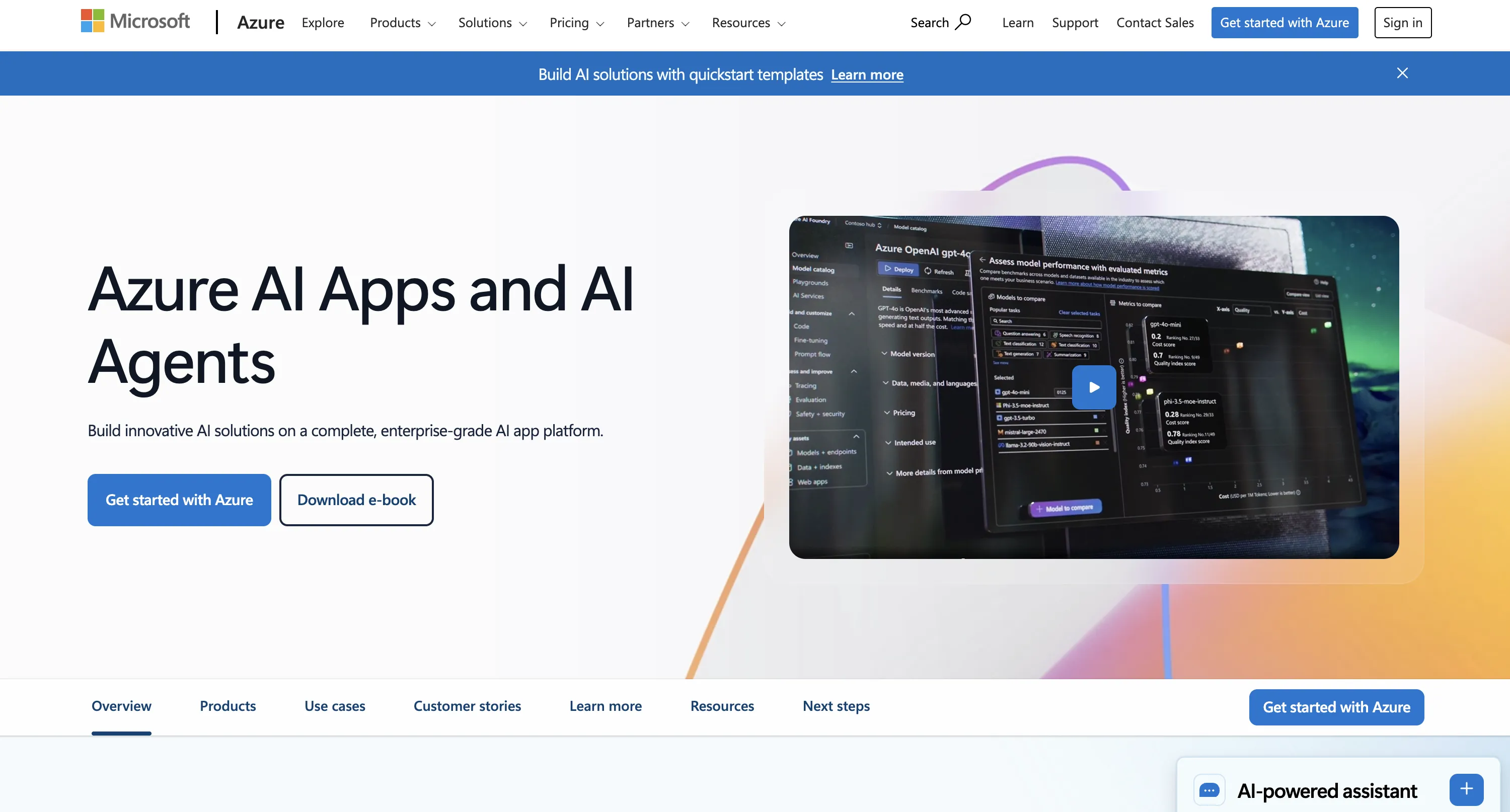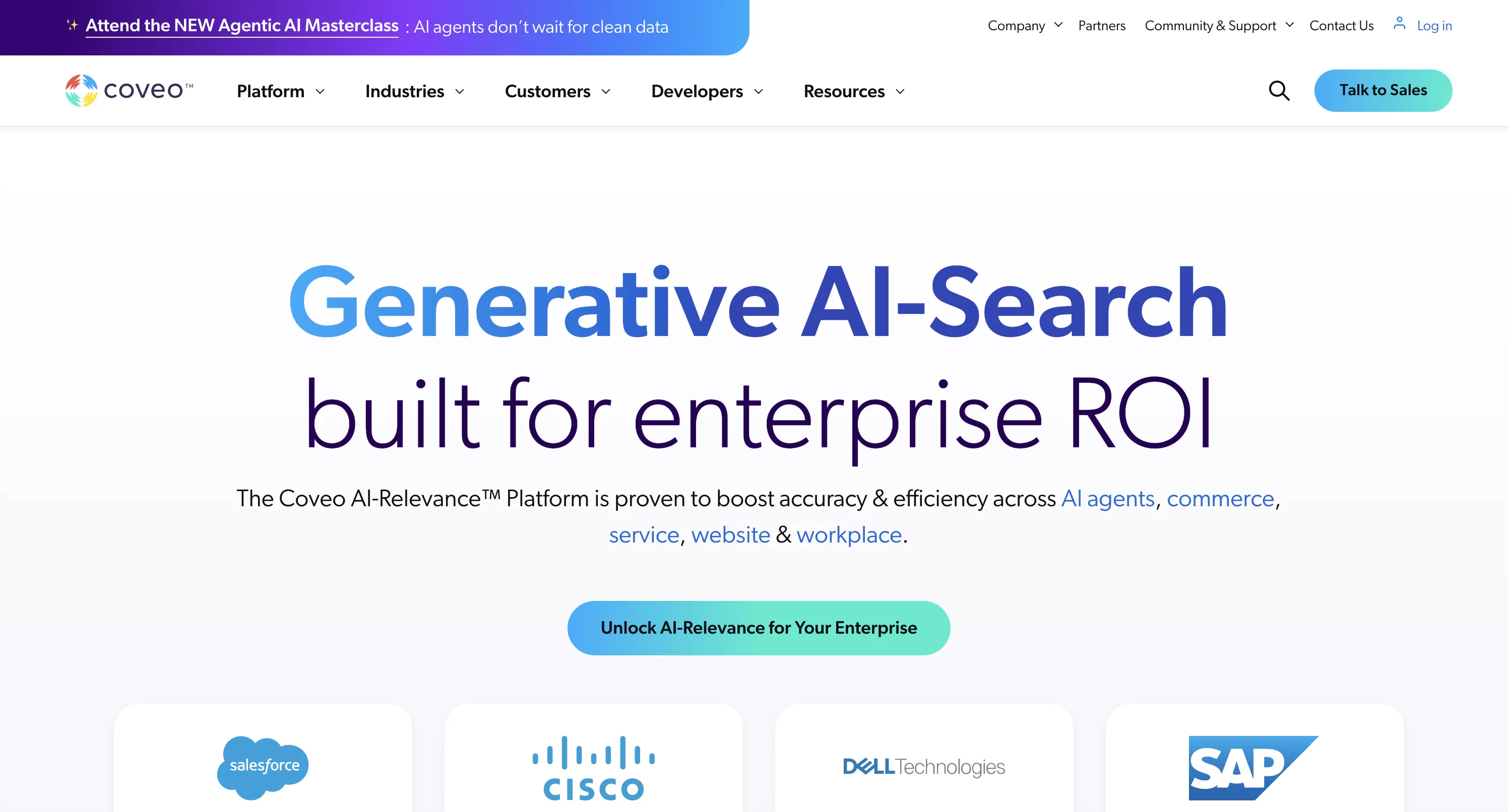Data Ingestion & Knowledge Sources
✅ Multi-Source Support – Databases, blob storage, PDF, DOCX, HTML via Azure pipelines ✅ Auto-Sync – Azure services keep indexed information current automatically
100+ Native Connectors – SharePoint, Salesforce, ServiceNow, Confluence, databases, file shares, Slack, websites merged into one indexOCR & Structured Data – Indexes scanned docs, intranet pages, knowledge articles, multimedia contentReal-Time Sync – Incremental crawls, push APIs, scheduled syncs keep content fresh
1,400+ file formats – PDF, DOCX, Excel, PowerPoint, Markdown, HTML + auto-extraction from ZIP/RAR/7Z archivesWebsite crawling – Sitemap indexing with configurable depth for help docs, FAQs, and public contentMultimedia transcription – AI Vision, OCR, YouTube/Vimeo/podcast speech-to-text built-inCloud integrations – Google Drive, SharePoint, OneDrive, Dropbox, Notion with auto-syncKnowledge platforms – Zendesk, Freshdesk, HubSpot, Confluence, Shopify connectorsMassive scale – 60M words (Standard) / 300M words (Premium) per bot with no performance degradation
✅ Azure Ecosystem – SDKs, REST APIs, Logic Apps, PowerApps (connectors )✅ Native Channels – Web widgets, Slack, Microsoft Teams integration✅ Low-Code Options – Custom workflows via low-code tools or full API
Atomic UI Components – Drop-in components for search pages, support hubs, commerce sites with generative answersNative Platform Integrations – Salesforce, Sitecore with AI answers inside existing toolsREST APIs – Build custom chatbots, virtual assistants on Coveo's retrieval engine
Website embedding – Lightweight JS widget or iframe with customizable positioningCMS plugins – WordPress, WIX, Webflow, Framer, SquareSpace native support5,000+ app ecosystem – Zapier connects CRMs, marketing, e-commerce toolsMCP Server – Integrate with Claude Desktop, Cursor, ChatGPT, WindsurfOpenAI SDK compatible – Drop-in replacement for OpenAI API endpointsLiveChat + Slack – Native chat widgets with human handoff capabilities
✅ RAG-Powered Answers – Semantic search + LLM generation for grounded responses✅ Hybrid Search – Keyword + semantic with optional ranking for relevance✅ Multilingual – Conversation history management from Azure portal
Uses Relevance Generative Answering (RGA)—a two-step retrieval plus LLM flow that produces concise, source-cited answers.
Respects permissions, showing each user only the content they’re allowed to see.
Blends the direct answer with classic search results so people can dig deeper if they want.
✅ #1 accuracy – Median 5/5 in independent benchmarks, 10% lower hallucination than OpenAI✅ Source citations – Every response includes clickable links to original documents✅ 93% resolution rate – Handles queries autonomously, reducing human workload✅ 92 languages – Native multilingual support without per-language config✅ Lead capture – Built-in email collection, custom forms, real-time notifications✅ Human handoff – Escalation with full conversation context preserved
✅ Full UI Control – Custom CSS, logos, welcome messages for branding✅ White-Labeling – Domain restrictions via Azure configuration✅ Search Behavior – Custom analyzers, synonym maps (config options )
Atomic components are fully styleable with CSS, making it easy to match your brand’s look and feel.
You can tweak answer formatting and citation display through configs; deeper personality tweaks mean editing the prompt.
Full white-labeling included – Colors, logos, CSS, custom domains at no extra cost2-minute setup – No-code wizard with drag-and-drop interfacePersona customization – Control AI personality, tone, response style via pre-promptsVisual theme editor – Real-time preview of branding changesDomain allowlisting – Restrict embedding to approved sites only
✅ Azure OpenAI – GPT-4, GPT-3.5 via native Azure integration✅ Prompt Control – Customizable templates and system prompts✅ Model Flexibility – Azure-hosted or external LLMs via API
Azure OpenAI GPT – Primary models via Azure OpenAI for high-quality generationBring Your Own LLM – Relevance-Augmented Passage Retrieval API supports custom modelsAuto-Tuning – Handles model tuning, prompt optimization; API override available
GPT-5.1 models – Latest thinking models (Optimal & Smart variants)GPT-4 series – GPT-4, GPT-4 Turbo, GPT-4o availableClaude 4.5 – Anthropic's Opus available for EnterpriseAuto model routing – Balances cost/performance automaticallyZero API key management – All models managed behind the scenes
Developer Experience ( A P I & S D Ks)
✅ Multi-Language SDKs – C#, Python, Java, JavaScript (Azure SDKs )✅ Documentation – Tutorials, sample code for index management and queries✅ Azure AD Auth – Secure API access via Azure portal
REST APIs & SDKs – Java, .NET, JavaScript for indexing, connectors, queryingUI Components – Atomic and Quantic components for fast front-end integrationEnterprise Documentation – Step-by-step guides for pipelines, index management
REST API – Full-featured for agents, projects, data ingestion, chat queriesPython SDK – Open-source customgpt-client with full API coveragePostman collections – Pre-built requests for rapid prototypingWebhooks – Real-time event notifications for conversations and leadsOpenAI compatible – Use existing OpenAI SDK code with minimal changes
✅ Enterprise Scale – Millisecond responses under heavy load (Microsoft Mechanics )✅ High Relevance – Hybrid search, semantic ranking, configurable scoring✅ Global Infrastructure – Low latency, high throughput worldwide
Pairs keyword search with semantic vector search so the LLM gets the best possible context.
Reranking plus smart prompts keep hallucinations low and citations precise.
Built on a scalable architecture that handles heavy query loads and massive content sets.
Sub-second responses – Optimized RAG with vector search and multi-layer cachingBenchmark-proven – 13% higher accuracy, 34% faster than OpenAI Assistants APIAnti-hallucination tech – Responses grounded only in your provided contentOpenGraph citations – Rich visual cards with titles, descriptions, images99.9% uptime – Auto-scaling infrastructure handles traffic spikes
Customization & Flexibility ( Behavior & Knowledge)
✅ Index Control – Custom analyzers, tokenizers, synonym maps for domain-specific search✅ Cognitive Skills – Plugin custom skills during indexing for specialized processing✅ LLM Tuning – Prompt customization for style and tone control
Fine-tune which sources and metadata the engine uses via query pipelines and filters.
Integrates with SSO/LDAP so results are tailored to each user’s permissions.
Developers can tweak prompt templates or inject business rules to shape the output.
Live content updates – Add/remove content with automatic re-indexingSystem prompts – Shape agent behavior and voice through instructionsMulti-agent support – Different bots for different teamsSmart defaults – No ML expertise required for custom behavior
✅ Pay-As-You-Go – Tier, partition, replica based (Pricing Guide )✅ Free Tier – Development/small projects; production tiers available✅ On-Demand Scaling – Add replicas/partitions; enterprise discounts available
Enterprise Licensing – Pricing based on sources, query volume, features99.999% Uptime – Scales to millions of queries, regional data centersAnnual Contracts – Volume tiers with optional premium support
Standard: $99/mo – 60M words, 10 botsPremium: $449/mo – 300M words, 100 botsAuto-scaling – Managed cloud scales with demandFlat rates – No per-query charges
✅ Enterprise Compliance – SOC, ISO, GDPR, HIPAA, FedRAMP (Azure Compliance )✅ Data Encryption – Transit/rest, customer-managed keys, Private Link isolation✅ Azure AD RBAC – Granular role-based access control and authentication
ISO 27001/27018, SOC 2 – Plus HIPAA-compatible deployments availablePermission-Aware – Granular access controls, users see only authorized contentPrivate Cloud/On-Prem – Deployment options for strict data-residency requirements
SOC 2 Type II + GDPR – Third-party audited complianceEncryption – 256-bit AES at rest, SSL/TLS in transitAccess controls – RBAC, 2FA, SSO, domain allowlistingData isolation – Never trains on your data
Observability & Monitoring
✅ Portal Dashboard – Track indexes, query performance, usage at glance✅ Azure Monitor – Custom alerts, dashboards (Azure Monitor )✅ Export Logs – API-based log and analytics export for analysis
Analytics Dashboard – Tracks query volume, engagement, generative-answer performancePipeline Logs – Exportable for deeper analysis and troubleshootingA/B Testing – Query pipeline experiments to measure impact, fine-tune relevance
Real-time dashboard – Query volumes, token usage, response timesCustomer Intelligence – User behavior patterns, popular queries, knowledge gapsConversation analytics – Full transcripts, resolution rates, common questionsExport capabilities – API export to BI tools and data warehouses
✅ Microsoft Support – Docs, Microsoft Learn modules, active community forums✅ Enterprise SLAs – Dedicated channels for mission-critical deployments✅ Developer Community – Large Azure ecosystem sharing best practices
Enterprise Support – Account managers, 24/7 help, extensive training programsPartner Network – Coveo Connect community with docs, forums, certified integrationsRegular Updates – Product releases and industry events for latest trends
Comprehensive docs – Tutorials, cookbooks, API referencesEmail + in-app support – Under 24hr response timePremium support – Dedicated account managers for Premium/EnterpriseOpen-source SDK – Python SDK, Postman, GitHub examples5,000+ Zapier apps – CRMs, e-commerce, marketing integrations
Additional Considerations
✅ Deep Integration – End-to-end solutions within Azure platform✅ Enterprise-Grade – Fine-grained tuning with proven reliability⚠️ Azure-First – Best for organizations already invested in Azure ecosystem
Coveo goes beyond Q&A to power search, recommendations, and discovery for large digital experiences.
Deep integration with enterprise systems and strong permissioning make it ideal for internal knowledge management.
Feature-rich but best suited for organizations with an established IT team to tune and maintain it.
Time-to-value – 2-minute deployment vs weeks with DIYAlways current – Auto-updates to latest GPT modelsProven scale – 6,000+ organizations, millions of queriesMulti-LLM – OpenAI + Claude reduces vendor lock-in
No- Code Interface & Usability
✅ Azure Portal – Create indexes, tweak analyzers, monitor performance intuitively✅ Low-Code Tools – Logic Apps, PowerApps for non-developers⚠️ Learning Curve – Advanced setups require technical expertise vs turnkey solutions
Admin Console – Atomic components enable minimal-code starts⚠️ Developer Involvement – Full generative setup requires technical resources
Best For – Teams with existing IT resources, more complex than pure no-code
2-minute deployment – Fastest time-to-value in the industryWizard interface – Step-by-step with visual previewsDrag-and-drop – Upload files, paste URLs, connect cloud storageIn-browser testing – Test before deploying to productionZero learning curve – Productive on day one
Market Position – Enterprise AI platform with production-ready RAG at global scaleTarget Customers – Azure-invested orgs needing SOC/ISO/GDPR/HIPAA/FedRAMP compliance, 99.999% SLAsKey Competitors – AWS Bedrock, Google Vertex AI, OpenAI Enterprise, Coveo, VectaraCompetitive Advantages – Azure ecosystem integration, hybrid search, native OpenAI, global infrastructureBest Fit – Organizations using Azure/Office 365 requiring enterprise compliance and regional residency
Market Position – Enterprise AI-powered search/discovery with RGA for large-scale knowledge managementTarget Customers – Large enterprises with complex content (SharePoint, Salesforce, ServiceNow, Confluence) needing permission-aware searchKey Competitors – Azure AI Search, Vectara.ai, Glean, Elastic Enterprise SearchCompetitive Advantages – 100+ connectors, hybrid search, permission-aware results, 99.999% uptime SLAPricing – Enterprise licensing higher than SaaS chatbots; best value for unified search across massive contentUse Case Fit – Knowledge hubs, support portals, commerce sites with generative answers
Market position – Leading RAG platform balancing enterprise accuracy with no-code usability. Trusted by 6,000+ orgs including Adobe, MIT, Dropbox.Key differentiators – #1 benchmarked accuracy • 1,400+ formats • Full white-labeling included • Flat-rate pricingvs OpenAI – 10% lower hallucination, 13% higher accuracy, 34% fastervs Botsonic/Chatbase – More file formats, source citations, no hidden costsvs LangChain – Production-ready in 2 min vs weeks of development
✅ Azure OpenAI – GPT-4, GPT-4o, GPT-3.5 Turbo native integration✅ Anthropic Claude – Available via Microsoft Foundry (late 2024/early 2025)✅ Multi-Model Platform – Only cloud with both Claude and GPT models✅ Model Flexibility – Azure-hosted or external LLMs via API✅ Prompt Templates – Customizable prompts for specific use cases✅ Enterprise Integration – Models integrated with Azure security/compliance/governance
Azure OpenAI GPT – Primary models via Azure OpenAI for high-quality generationModel Flexibility – Relevance-Augmented Passage Retrieval API supports custom LLMsAuto-Tuning – Handles model tuning, prompt optimization automatically; API override availableSearch Integration – LLM tightly integrated with keyword + semantic search pipeline
OpenAI – GPT-5.1 (Optimal/Smart), GPT-4 seriesAnthropic – Claude 4.5 Opus/Sonnet (Enterprise)Auto-routing – Intelligent model selection for cost/performanceManaged – No API keys or fine-tuning required
✅ Agentic Retrieval (2024) – LLM-powered query decomposition into parallel subqueries for chat✅ Hybrid Search – Vector + keyword + semantic with relevance tuning✅ Vector Store – Long-term memory, knowledge base for RAG apps✅ Framework Support – Azure Semantic Kernel, LangChain for RAG workflows✅ Import Wizard – Automates parsing, chunking, enrichment, embedding pipeline✅ Query Enhancement – Rewriting, synonyms, paraphrasing, spelling correction
RGA (Relevance Generative Answering) – Two-step retrieval + LLM producing source-cited answersHybrid Search – Keyword + semantic vector search for optimal LLM contextReranking & Smart Prompts – Keeps hallucinations low, citations precisePermission-Aware – SSO/LDAP integration shows only authorized content per userQuery Pipelines – Fine-tune sources, metadata, filters for retrieval control99.999% Uptime – Scalable architecture for heavy query loads, massive content sets
GPT-4 + RAG – Outperforms OpenAI in independent benchmarksAnti-hallucination – Responses grounded in your content onlyAutomatic citations – Clickable source links in every responseSub-second latency – Optimized vector search and cachingScale to 300M words – No performance degradation at scale
✅ Enterprise Search – 40% productivity boost (9 hours/week saved per employee)✅ Customer Service – Self-service chatbots, real-time agent support, coaching, summarization✅ RAG Applications – 50%+ Fortune 500 companies (OpenAI, Otto, KPMG, PETRONAS)✅ Knowledge Management – AI-driven insights for organizational knowledge bases✅ Multi-Industry – Retail, financial, healthcare, manufacturing, government sectors
Industries – Financial Services, Telecommunications, High-Tech, Retail, Healthcare, ManufacturingInternal Knowledge – Enterprise systems integration, permissioning for documentation, knowledge hubsCustomer Support – Support hubs with generative answers from knowledge bases, ticket historyCommerce Sites – Product search, recommendations, AI-powered discovery featuresContent Scale – Large distributed content across SharePoint, databases, file shares, Confluence, ServiceNowTeam Sizes – Large enterprises with IT teams, millions of queries
Customer support – 24/7 AI handling common queries with citationsInternal knowledge – HR policies, onboarding, technical docsSales enablement – Product info, lead qualification, educationDocumentation – Help centers, FAQs with auto-crawlingE-commerce – Product recommendations, order assistance
✅ Certifications – SOC, ISO, GDPR, HIPAA, FedRAMP (Azure Compliance )✅ Encryption – Transit (SSL/TLS) and rest with customer-managed keys✅ Private Link – Enhanced isolation for security✅ Azure AD RBAC – Granular access control with secure authentication✅ 99.999% SLA – Enterprise reliability with regional data residency✅ Security Monitoring – Continuous oversight via Azure Monitor
ISO 27001/27018, SOC 2 – International security, privacy standards for enterprisesHIPAA-Compatible – Deployments available for healthcare compliance requirementsGranular Access Controls – Permission-aware search, SSO/LDAP integrationPrivate Cloud/On-Prem – Options for strict data-residency requirements99.999% Uptime SLA – Regional data centers for mission-critical infrastructure
SOC 2 Type II + GDPR – Regular third-party audits, full EU compliance256-bit AES encryption – Data at rest; SSL/TLS in transitSSO + 2FA + RBAC – Enterprise access controls with role-based permissionsData isolation – Never trains on customer dataDomain allowlisting – Restrict chatbot to approved domains
✅ Free Tier – 50 MB storage for dev/small projects✅ Basic Tier – Entry production with fixed storage (no partition scaling)✅ Standard Tiers – Scalable throughput via partitions and replicas✅ Storage Optimized – High-volume data at reduced $/TB✅ 2024 Capacity Boost – 5-6x storage increase free (Pricing )✅ Tier Flexibility (2024) – Change tiers without downtime; enterprise discounts available
Enterprise Licensing – $600 to $1,320 depending on sources, query volume, featuresPro Plan – Entry-level with core search, RGA for smaller enterprisesEnterprise Plan – Full-featured with advanced capabilities, higher volumes, premium supportAnnual Contracts – Volume tiers with optional premium support packages⚠️ Consumption-Based – Pricing model can make costs hard to predict
Best Value For – Unified search across massive content, millions of queries
Standard: $99/mo – 10 chatbots, 60M words, 5K items/botPremium: $449/mo – 100 chatbots, 300M words, 20K items/botEnterprise: Custom – SSO, dedicated support, custom SLAs7-day free trial – Full Standard access, no chargesFlat-rate pricing – No per-query charges, no hidden costs
✅ Enterprise Support – Microsoft infrastructure with dedicated mission-critical channels✅ SLA Plans – Guaranteed response times and uptime commitments✅ Microsoft Learn – Docs, tutorials, modules (docs )✅ Community Forums – Active Azure developers sharing best practices✅ Portal Dashboard – Integrated monitoring for indexes, queries, analytics✅ Official SDKs – REST APIs, C#, Python, Java, JavaScript (SDKs )
Enterprise Support – Account managers, 24/7 help, guaranteed response timesPartner Network – Certified integrations via Coveo Connect communityDocumentation – Step-by-step guides for pipelines, index management, connectorsTraining Programs – Admin console, Atomic components, developer integrationRegular Updates – Product releases, industry events for latest trends
Documentation hub – Docs, tutorials, API referencesSupport channels – Email, in-app chat, dedicated managers (Premium+)Open-source – Python SDK, Postman, GitHub examplesCommunity – User community + 5,000 Zapier integrations
Limitations & Considerations
⚠️ Free Tier Limits – 50 MB storage, shared resources, no partitions/replicas⚠️ No Pause/Stop – Pay continuous fixed rate; resources allocated when created⚠️ Vector Limitations – Index sizes restricted by tier memory; regional infrastructure gaps⚠️ Learning Curve – Advanced customizations require trial-and-error, technical expertise⚠️ Cost Structure – Restrictive for small teams; costs scale quickly with usage⚠️ Azure Lock-In – Less competitive for non-Azure customers; best for Azure ecosystem
⚠️ Developer Involvement – Full generative setup requires technical resources
⚠️ Cost Predictability – Consumption-based pricing hard to predict for enterprise scale
⚠️ IT Team Needed – Best for organizations with established technical teams
⚠️ Enterprise Focus – Optimized for enterprises vs. SMBs or startups
NOT Ideal For – Small businesses, plug-and-play chatbot needs, immediate no-code deployment
Managed service – Less control over RAG pipeline vs build-your-ownModel selection – OpenAI + Anthropic only; no Cohere, AI21, open-sourceReal-time data – Requires re-indexing; not ideal for live inventory/pricesEnterprise features – Custom SSO only on Enterprise plan
✅ Agentic Retrieval (2024) – Multi-query pipeline for complex chat questions (docs )✅ Query Decomposition – LLM breaks complex queries into focused subqueries✅ Parallel Execution – Subqueries run simultaneously with semantic reranking✅ 40% Performance Boost – Improved answer relevance vs traditional RAG✅ Knowledge Bases – Multi-source grounding without siloed pipelines (Azure AI Foundry)✅ Chat History – Contextually aware responses from conversation history
Agentic AI Integration – Coveo for Agentforce, expanded API suite, Design Partner Program (2024-2025)Agent API Suite – Search API, Passage Retrieval API, Answer API for grounding agentsSalesforce Agentforce – Native integration for customer service, sales, marketing agentsAWS RAG-as-a-Service – MCP Server for Amazon Bedrock AgentCore, Agents, Quick Suite (Dec 2024)Four Tools – Passage Retrieval, Answer gen (Amazon Nova), Search, FetchSecurity-First – Inherits document/item-level permissions automatically for trusted answers
Custom AI Agents – Autonomous GPT-4/Claude agents for business tasksMulti-Agent Systems – Specialized agents for support, sales, knowledgeMemory & Context – Persistent conversation history across sessionsTool Integration – Webhooks + 5,000 Zapier apps for automationContinuous Learning – Auto re-indexing without manual retraining
R A G-as-a- Service Assessment
✅ TRUE RAG-AS-A-SERVICE – End-to-end enterprise RAG with native Azure integration✅ Performance Metrics – Prompt variations, retrieval accuracy, response evaluation✅ AI-Assisted Metrics – 3 metrics requiring no ground truth for evaluation✅ Hybrid Optimization – Vector + keyword + semantic with relevance tuning✅ Import Wizard – Automates parsing, chunking, enrichment, embedding pipeline✅ 40% Accuracy Boost – vs standalone LLMs (study )
Platform Type – Enterprise search with RAG-as-a-Service, Relevance Generative Answering (RGA)RAG Launch – AWS RAG-as-a-Service announced December 1, 2024 as cloud-native offering40% Accuracy Improvement – RAG increases base model accuracy according to industry studiesHybrid Search – Keyword, vector, hybrid search with relevance tuning100+ Connectors – SharePoint, Salesforce, ServiceNow, Confluence, databases, SlackBest For – Enterprises with distributed content needing permission-aware search, knowledge hubs, generative answers
Platform type – TRUE RAG-AS-A-SERVICE with managed infrastructureAPI-first – REST API, Python SDK, OpenAI compatibility, MCP ServerNo-code option – 2-minute wizard deployment for non-developersHybrid positioning – Serves both dev teams (APIs) and business users (no-code)Enterprise ready – SOC 2 Type II, GDPR, WCAG 2.0, flat-rate pricing











Join the Discussion
Loading comments...